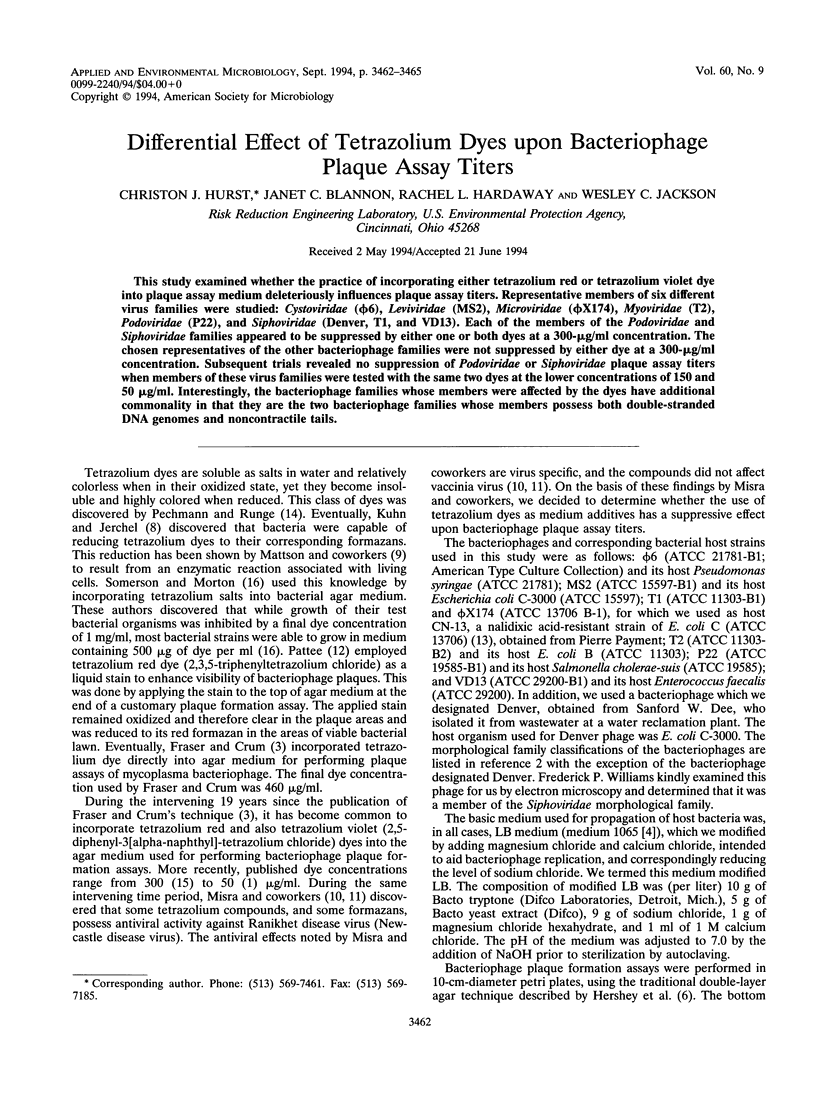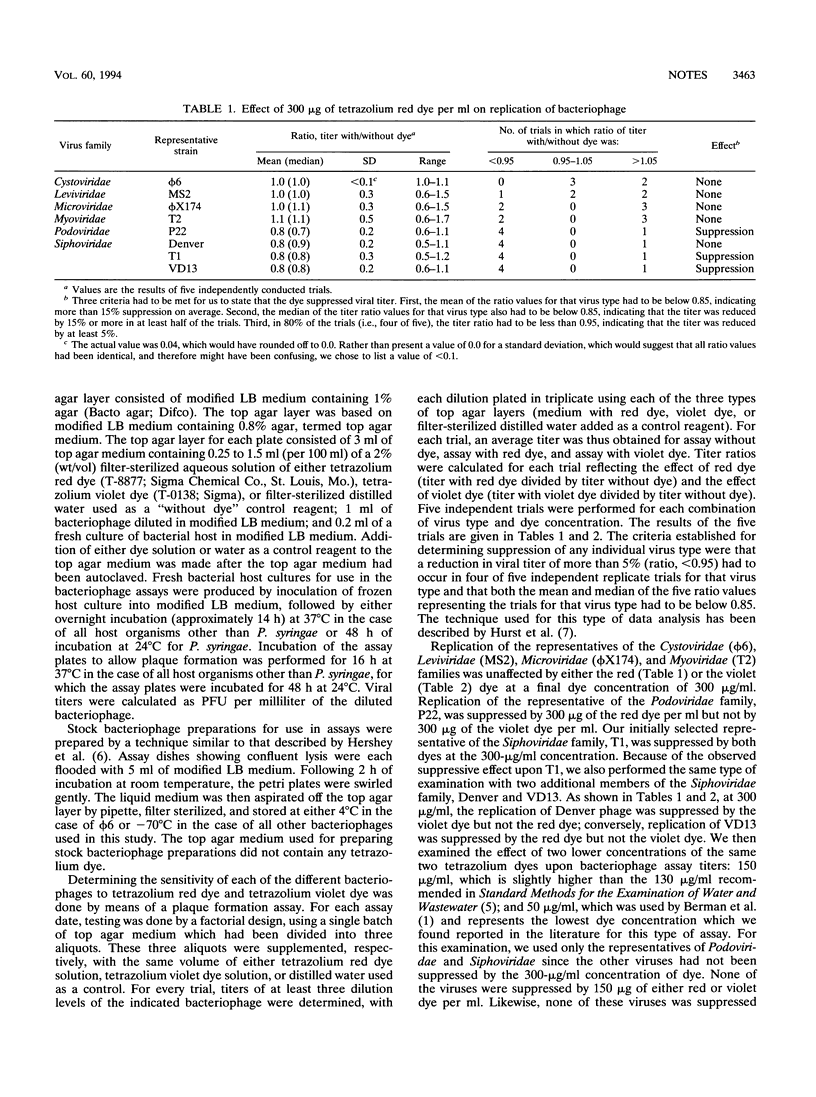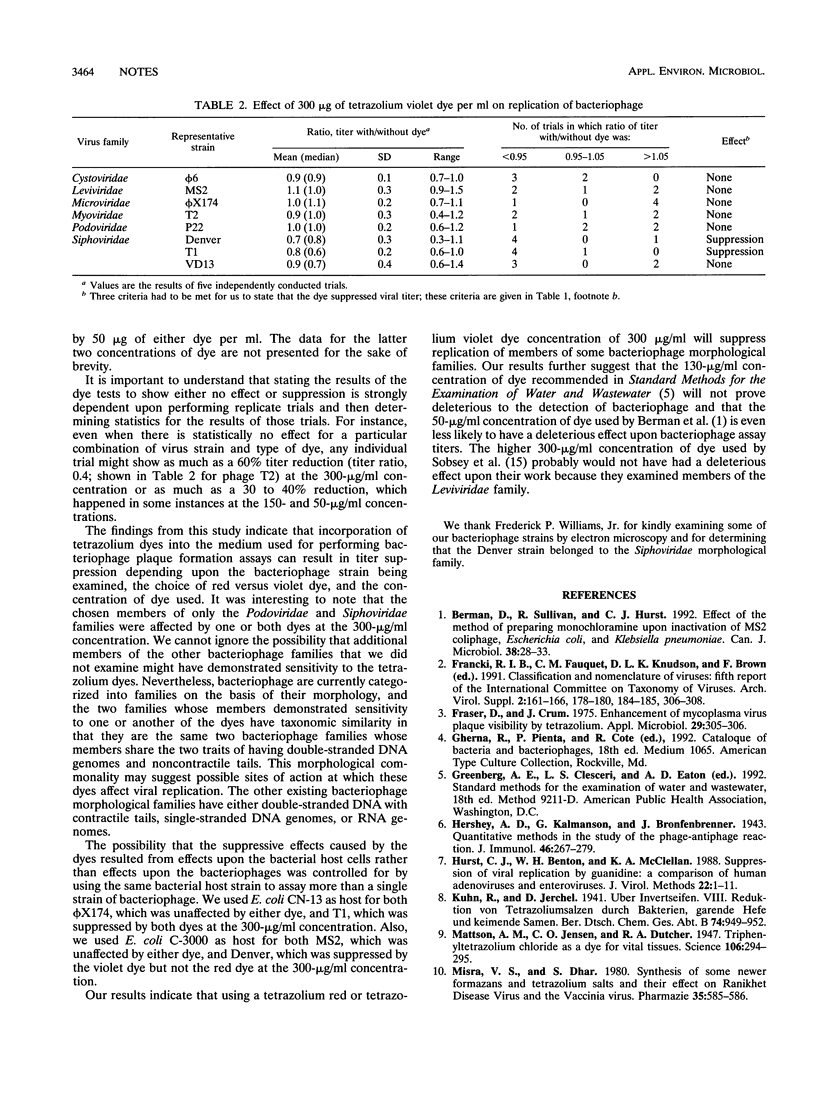Abstract
This study examined whether the practice of incorporating either tetrazolium red or tetrazolium violet dye into plaque assay medium deleteriously influences plaque assay titers. Representative members of six different virus families were studied: Cystoviridae (ϕ6), Leviviridae (MS2), Microviridae (ϕX174), Myoviridae (T2), Podoviridae (P22), and Siphoviridae (Denver, T1, and VD13). Each of the members of the Podoviridae and Siphoviridae families appeared to be suppressed by either one or both dyes at a 300-μg/ml concentration. The chosen representatives of the other bacteriophage families were not suppressed by either dye at a 300-μg/ml concentration. Subsequent trials revealed no suppression of Podoviridae or Siphoviridae plaque assay titers when members of these virus families were tested with the same two dyes at the lower concentrations of 150 and 50 μg/ml. Interestingly, the bacteriophage families whose members were affected by the dyes have additional commonality in that they are the two bacteriophage families whose members possess both double-stranded DNA genomes and noncontractile tails.
Full text
PDF



Selected References
These references are in PubMed. This may not be the complete list of references from this article.
- Berman D., Sullivan R., Hurst C. J. Effect of the method of preparing monochloramine upon inactivation of MS2 coliphage, Escherichia coli, and Klebsiella pneumoniae. Can J Microbiol. 1992 Jan;38(1):28–33. doi: 10.1139/m92-004. [DOI] [PubMed] [Google Scholar]
- Fraser D., Crum J. Enhancement of mycoplasma virus plaque visibility by tetrazolium. Appl Microbiol. 1975 Feb;29(2):305–306. doi: 10.1128/am.29.2.305-306.1975. [DOI] [PMC free article] [PubMed] [Google Scholar]
- Hurst C. J., Benton W. H., McClellan K. A. Suppression of viral replication by guanidine: a comparison of human adenoviruses and enteroviruses. J Virol Methods. 1988 Oct;22(1):1–11. doi: 10.1016/0166-0934(88)90082-1. [DOI] [PubMed] [Google Scholar]
- Mattson A. M., Jensen C. O., Dutcher R. A. Triphenyltetrazolium Chloride as a Dye for Vital Tissues. Science. 1947 Sep 26;106(2752):294–295. doi: 10.1126/science.106.2752.294-a. [DOI] [PubMed] [Google Scholar]
- Misra V. S., Dhar S., Chowdhary B. L. Synthesis of some newer formazans and tetrazolium salts as antiviral agents. Pharmazie. 1978 Dec;33(12):790–792. [PubMed] [Google Scholar]
- Misra V. S., Dhar S. Synthesis of some newer formazans and tetrazolium salts and their effect on Ranikhet disease virus and the vaccinia virus. Pharmazie. 1980;35(10):585–586. [PubMed] [Google Scholar]
- Pattee P. A. Use of tetrazolium for improved resolution of bacteriophage plaques. J Bacteriol. 1966 Sep;92(3):787–788. doi: 10.1128/jb.92.3.787-788.1966. [DOI] [PMC free article] [PubMed] [Google Scholar]
- Payment P. Fate of human enteric viruses, coliphages, and Clostridium perfringens during drinking-water treatment. Can J Microbiol. 1991 Feb;37(2):154–157. doi: 10.1139/m91-023. [DOI] [PubMed] [Google Scholar]
- SOMERSON N. L., MORTON H. E. Reduction of tetrazolium salts by pleuropneumonialike organisms. J Bacteriol. 1953 Mar;65(3):245–251. doi: 10.1128/jb.65.3.245-251.1953. [DOI] [PMC free article] [PubMed] [Google Scholar]


